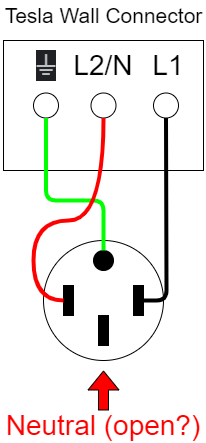Edit: This would work if the Tesla Wall Connector instructions permitted a cord-and-plug connection. They do not.
That is fine. Just because the 14-50 socket offers both hots and neutral doesn't mean the appliance needs to take it.
Now, let's do a few health checks on this circuit. On a NEMA 14-50 the breaker must be 50A or 40A and the wires must be at least large enough for that ampacity. The Wall Connector can go as high as 60A (or 80A?) but the NEMA 14-50 socket and plug cannot. So the Wall Connector must be commissioned to <= breaker trip.
The cord must be actual appliance cord, and not Romex. It needs 3 wires (no requirement for 4th wire). The white is used as a hot, do not connect it to neutral. Must be 6 AWG for 50A or 8 AWG for 40A.
The EVSE already has a "Smart GFCI" onboard. This GFCI is able to self-reset itself a number of times (the fault often clears, so this is worth doing), and if it fails utterly, it can message your phone to warn you that you have a problem. This satisfies the January 2023 GFCI requirement for a hardwired EVSE but does nothing for a plug-in EVSE.
If your state has adopted NEC 2020, you have two choices: #1 hard-wire the EVSE, replacing the socket with a disconnect switch. #2 install a Stupid GFCI breaker ($100). The Stupid GFCI will trip at the same time as the Smart GFCI, doing a hard power cut, breaking the EVSE's retry and notice abilities, and you will get a surprise in the morning.

